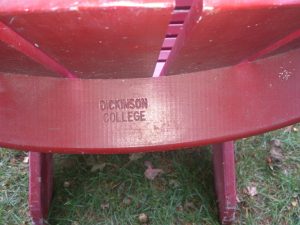We may receive a commission when you use our affiliate links. However, this does not impact our recommendations.

Take inspiration for building outdoor furniture from your last summer trip. I took this picture in Carlisle, Pennsylvania, in September.
Community members politely informed me that I forgot at least two important tools for any basic woodworking kit in my recent post. Those tools are imagination and snacks.
Here in northern New England we are currently experiencing a few weeks of rugged weather during which I’m finding that imagination and snacks are in fact the two most important tools for my shop. Today, for example, the challenges to normal work and travel are intermittent power outages and a hard rain on top of a couple feet of snow and ice. But that’s not stopping me from imagining a balmy summer, including Adirondack chairs to sit on. Start building outdoor furniture now if you want to enjoy it in June – that’s what I say.
5 Steps for Building Outdoor Furniture in January
1. Imagine a sunny sky.
2. Eat a summery snack. Haven’t you had enough Christmas cookies by now?
3. Decide what wood to use. Christopher Schwarz directed me to a handy list of rot-resistant species, and I have it narrowed down to a shortlist to seek out – cypress, white oak and Douglas fir. My final choice will be price-dependent and will, of course, take workability into account.
4. Find some good outdoor furniture plans that appeal to you. If it’s Adirondack chairs you want, we have one of the best free plans around. Click here.
5. Start sketching out the work as it will actually occur in your shop, solving any tool problems in advance. The cheapest and best tools are the ones you can either avoid buying altogether or source well ahead of time. That way you’re not stuck going straight to the store and paying full price for the gadget you need just to get through a single step or challenge.
Learning how to build outdoor furniture is one of my New Year’s resolutions. Each of our editors has written a short list of 2014 goals and we’ll be publishing the ideas on ShopWoodworking.com soon, so stay tuned!
Have you already built the Adirondack chairs mentioned above? Please share your experiences, challenges and solutions below so everyone can benefit from what you learned.
–Dan Farnbach
Here are some supplies and tools we find essential in our everyday work around the shop. We may receive a commission from sales referred by our links; however, we have carefully selected these products for their usefulness and quality.









I’ll recommend a different wood for durability: Black Locust. It is heavy, but straight grained and extremely rot resistant.
I did my deck in it, and it is holding up great with no sealing or staining.
Here in the Northwest nobody I know uses Doug fir for outdoor projects. Cedar is much more rot-resistant and it’s very easy to work, but watch out for slivers.
Hey, these are great ideas everybody! For those who may wish to share photos of what you have completed … you can always email us editors individually, but an even better format is to post a photo on one of our social media pages. That way everyone in the community can see, which is more informative and fun!
Here’s how:
Like us on Facebook: http://www.facebook.com/popularwoodworking … then post your photo and tag “Popular Woodworking.”
Follow us on Twitter: http://www.twitter.com/pweditors … then Tweet your picture at us and I will retweet it to our fans.
I’ve got to second the motion on “plastic” wood (Trex). Last year I found some at Lowe’s that was on sale for a terrific price. I grabbed it up and used it to build 2 Adirondack chairs. It was thicker and heavier than the wood that most people would use for the project, but I was willing to sacrifice some portability for the benefits. The prime benefit for me was the fact that these chairs require zero maintenance. Other benefits are that the material is as easy to work with as wood, measuring, cutting, and assembly are neither temperature nor moisture dependent, and it required little to no finishing – it has a wood grain that doesn’t require sanding, staining, or sealing.
Next spring I will be truly enjoying my project – especially when I see my neighbors pulling out their Adirondacks for their yearly maintenance. While they are working hard at cleaning, sanding, and resealing their chairs I will be working hard trying not to laugh as I enjoy my cool, refreshing beverage while basking in the warm spring sun in my zero maintenance Adirondack chair.
Dan – I have to agree with mcsteff above about a template for the pieces for Norm’s chair design (makes it much easier). I’ve built 6 of them now and Norm’s design was great. It’s easy to get out of the chair and very solid. The only thing I have found is that if you are much over 6′ tall, you are going to want to extend the length of the back pieces accordingly. I used pressure-treated 5/4 pine and painted them bright colors. Send me your email and I’ll send you a picture.
Have fun!
Dan
I was going to build a bench around the tree in my front yard, then the tree had to go. I’m now waiting for the new tree to grow tall enough to install a bench. The old tree is in my garage.
Dan
I have built a dozen of Norm’s chairs directly from his first book. I scaled up the plans onto some 1/4″ Luan (underlayment…cheap) making patterns. I used the first patterns for six of those chairs for myself and friends; then a fellow helping me ‘clean shop’ sawed them up as firewood so I scaled up another batch of Luan templates. I have put those in a safe place and have used them for another half dozen. I used spf and painted them. I also used some WEST epoxy for the ground contact spots. The last ones I built for myself (3 of them) and they are still going strong after twelve+ years – I have refinished them twice. They have a nice patina and are still very comfortable (thanks, Norm). Their heaviness comes in handy when the wind pipes up around here- don’t move in an eighty mile per hour storm we recently had. Make the templates; you won’t be sorry when others come around asking for a copy or two. Good luck. ~Mark
Making an Adirondack chair is no preparation for making a real chair; believe me, I know. That being said, let me warn you to countersink the fastener heads deep or else they’ll feel like branding irons on your butt after they’ve been exposed to the hot sun for very long; this applies to the backrest and arms also. Norm’s design improves on older designs in that it allows you to get up and out of the chair easily but some Adirondack chair construction makes it difficult to exit the chair quickly and those superheated fastener heads will have time to leave their mark.
Composite decking material may be OK if you keep the unsupported lengths to less than 20″. Composites have no long grain for strength and manufacturers warn against excessive spans. Granted, the load is well spread on a chair but there is always someone who will decide to stand on the chair and create a concentrated load. I know, the composite material looks good and has no maintenance compared to wood, but be careful.
I have built a number of chairs using western red cedar – it is light, strong, and weather resistant, not to mention, readily available here (southern Ontario). I also had a picnic table that lasted from 1979 until 2013. The lightness is a asset if you frequently relocate the chairs. I would think that white oak would be a little heavy unless you have a forklift handy.
In the picture the chair is made of plastic. Can you recommend a source of plastic appropriate for outside chairs? What thicknesses are appropriate for the seat? for the legs?, etc. Has anyone tried plastic decking material? Thinner plastic fascia boards are also available (and are typically wider). All can be cut with normal wood tools. Any issues of concern when using plastic? Thanks
Here’s a plan for an Adirondack loveseat that worked really well for me.
http://www.mitzenmacher.net/blog/?p=1072
I used redwood reclaimed from my kids’ swingset (they’re all grown).
My “warmup” was to build a single chair from plans and a really well done instructional video series from Lowes.
http://www.youtube.com/watch?v=8ovydDWggqE&list=SPE6EA65CC1F442782&index=1
I used treated lumber for the legs, and nice pine for the seat, arms, and back.
I’m considering this folding plan from Lee Valley – http://tinyurl.com/nduy8qf
On my to-do list for camping this summer. I will probably use cypress. Found some plans that I’ve wanted to build for years.
http://www.minwax.com/wood-projects/pdfs/intermediate-project-patio-chair-and-love-seat.pdf